DIY freezer probe and unfreezing alert
It’s the fourth this year that the freezer is left opened, but this time for a whole day. My lady was not happy at all :-(. It’s time to us the magical of smarthome technology to prevent future problems !
J’avais pensé utiliser un module FGBS321 de fibaro avec une sonde 1-wire pour réaliser cette sonde de congélateur. Cependant cet ensemble nécessitait un fil d’alimentation et un investissement certains pour une fonction aussi simple que la prise de température.
J’ai finalement opté pour une solution faite maison, sans alimentation et à petit prix. Basée sur les modules Oregon Scientific, la sonde est compatible avec de nombreuses box domotique dont la eedomus (avec module RFXTRX433)
I thought about using a Fibaro FGBS321 module associated with a 1-wire probe to construct this freezer probe . However, it would require an external power supply and a price shouldn’t be so low compared to the simple function we want to achieve which is temperature measurement.
I finally opted for a cheap homemade solution. Based on the Oregon Scientific module, the probe is compatible with many home automation controllers and particularly eedomus (with RFXTRX433 extension)
The freezer probe
Needed equipment
You’ll need those parts and equipment
 |
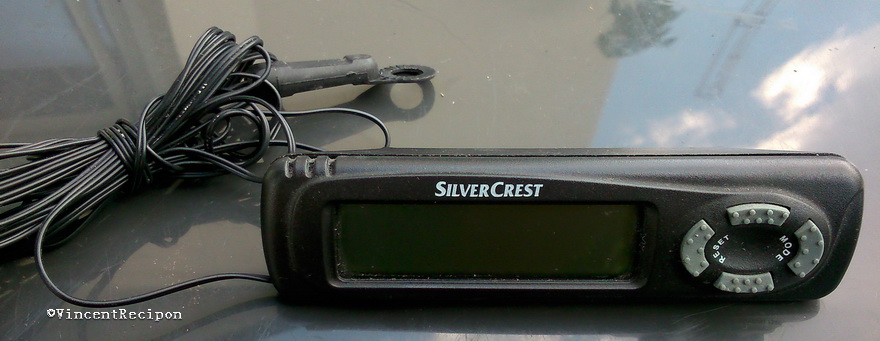 |
![fer_a_souder_002[1]](http://www.vrdigitalworld.com/wp-content/uploads/2014/11/fer_a_souder_0021.jpg) |
- An Oregon Scientific THGR122N thermo-hygro probe
Available in all smarthome stores for less than 30€ - A magnetic grip kit for smoke detector called “Safe & Secure”
bought to Electrodépôt for around 4€ - a internal/external temperature probe for cars which includes a wired external probe
Bought in a supermarket a long time ago for some euros - a soldering iron is also necessary
The principle
There are various technologies for measuring temperature in electronic products. However, for products not requiring high precision and measuring ambient temperatures, this are NTC thermistors that are mostly used. In this kind of product those are 10K thermistors that we mostly find, those one having an impedance equal to 10 kilo ohms at 25 ° C. So, there is a good chance to have a measure that remains consistent when re-using a temperature sensor from a device to another.
Be careful though, the original accuracy of the sensor is not the same, the calibration of the device is lost.
In this use case however we need information when the temperature rises significantly, we don’t really care about the static temperature precision.
The assembly
Alerts programming
The temperature sensor will be automatically detected by your eedomus controller and will propose to install this new device. I advise you to turn on the alarm on loss of connection located in the advanced settings if you have some difficulty to receive the signal from the probe through the various concret walls and slabs like me:
To manage the state of the freeze, I’ve created a virtual peripheral that will contain its status. To do so, we have to follow the menu
Configuration –> Peripherals –> Add a new periphéral –> Other type of peripheral
The value list for this new peripheral has been configured to contains those states :
The state is changed mainly using a macro associated to this virtual peripheral and also some programming rules. Status evolution is depending on time that the door is opened. The macro is doing the timing evolution of the status :
This macro is triggered by a rule depending on freezer temperature. If temperature increases above a threshold, -14°C in my case, macro is launched:
On the contrary, a rule detects the temperature is decreasing to normal situation. In this case the macro is disabled and the status of the freezer is reset to “Everything is Ok”
I’ve created also three other rules that react on status change:
- Vocal alert if freezer door is maybe opened
- Vocal alert and SMS sending every 2 hours is freezer door is opened
- SMS sent every hour in case of important problem
Conclusion
Through the reuse of electronic devices already available, I’ve built a cheap temperature sensor for freezer which is compatible with many smarthome controller. Although the measurement accuracy is no longer guaranteed, the temperature difference between the measurement and the reality seems to be less than 1 ° C (my freezer also have a temperature indicator).
The unit is battery operated (2 AAA). They have the same lifetime than without hardware modification, ie a little over a year.
Detecting an open door problem can only be done on a time period, to avoid false alarms. Eedomus macros are used to do this temporisation.
The location of the sensor in the freezer is also important. In my case if the probe is located at the bottom of the freezer, measuring temperature drops when the door is opened due to convective airflow which drives the cold air down. So I moved my probe upwards to get a result easier to deal with.

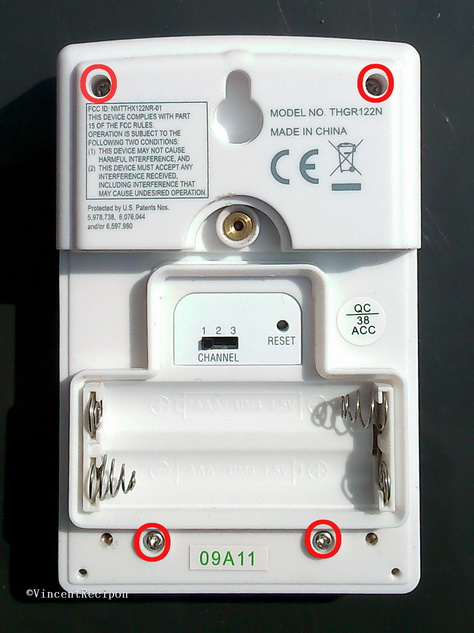
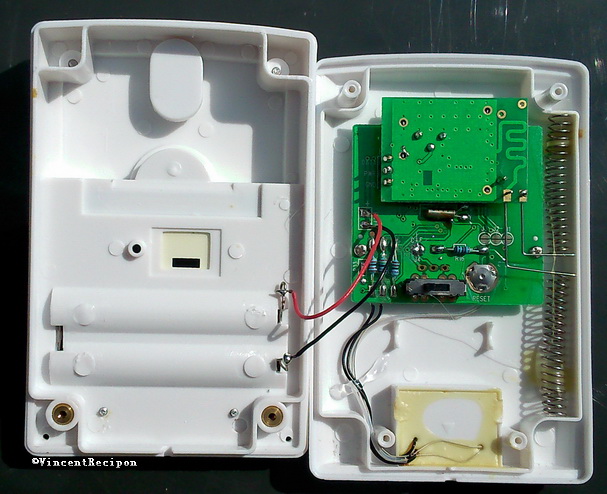
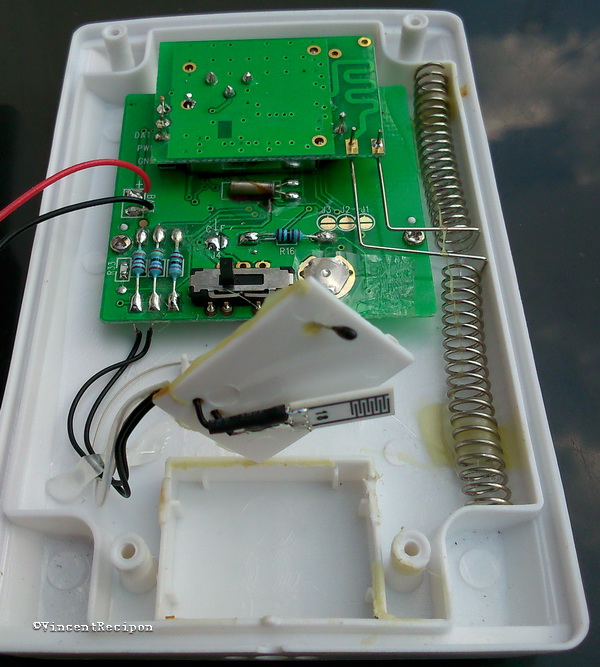
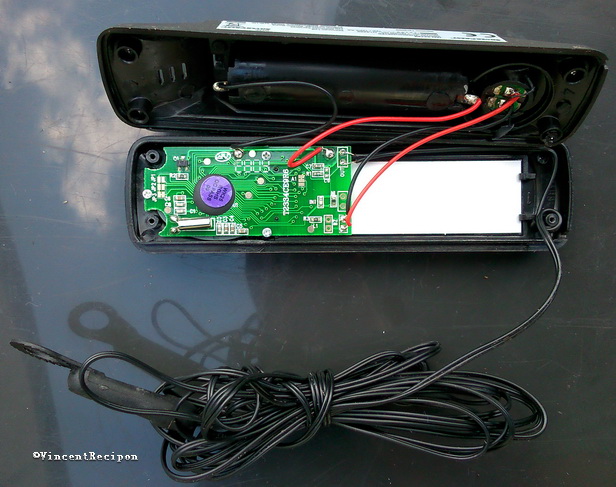
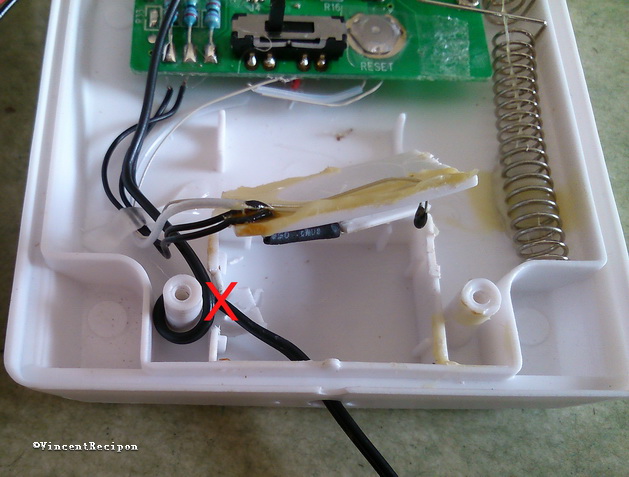
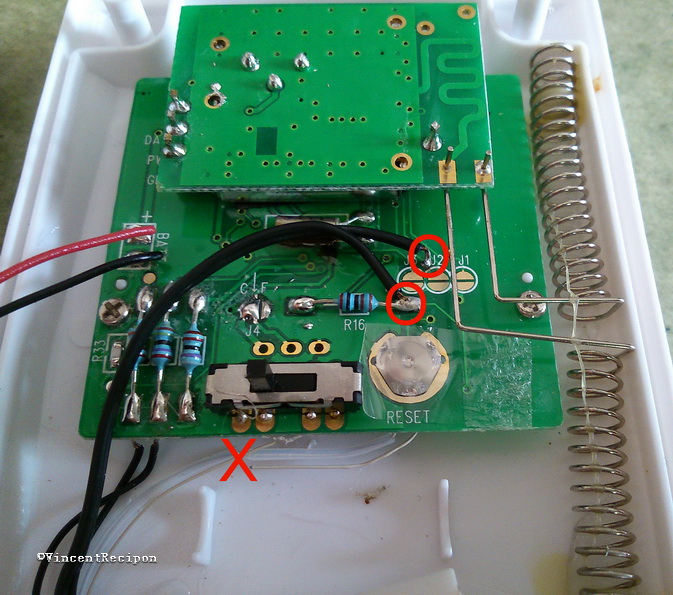
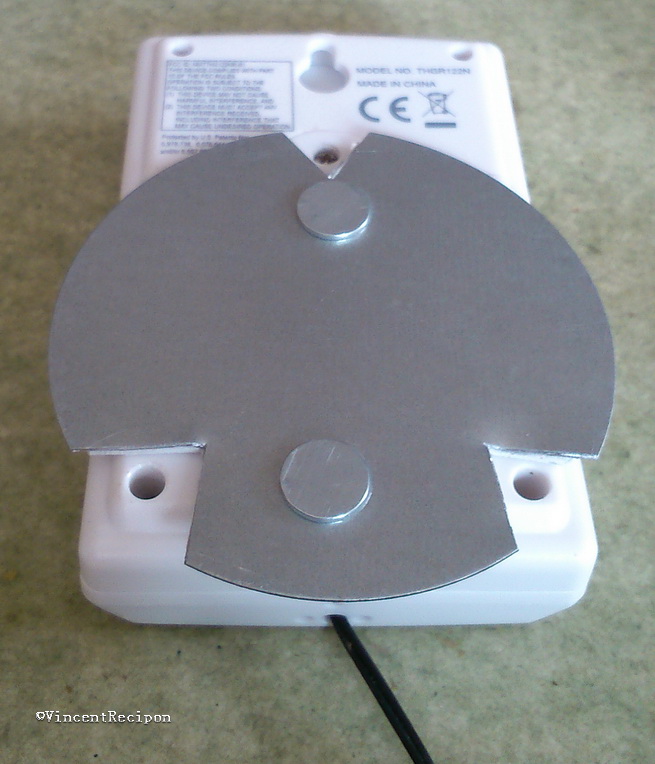
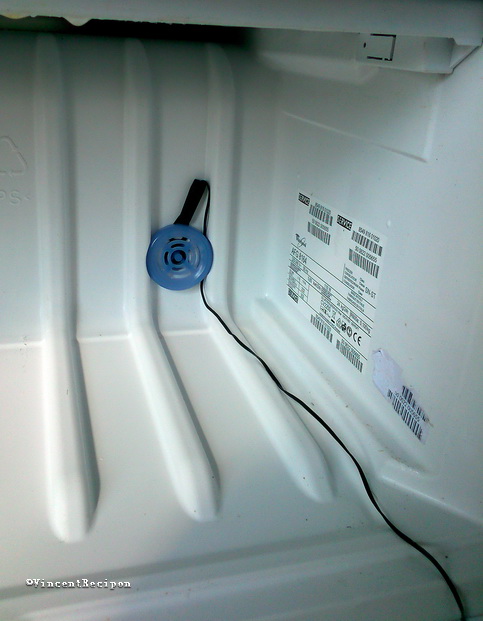
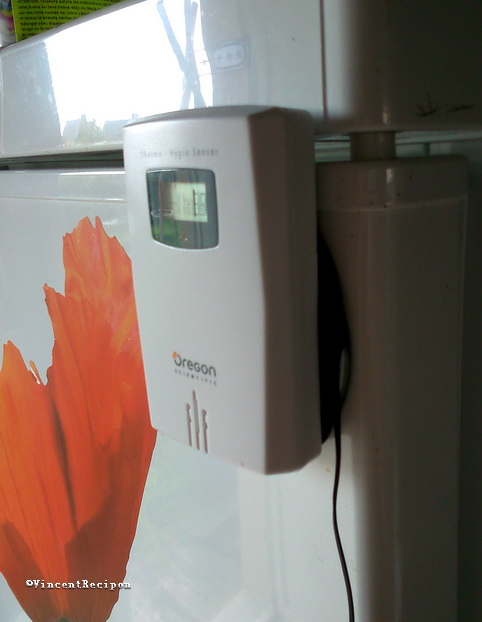
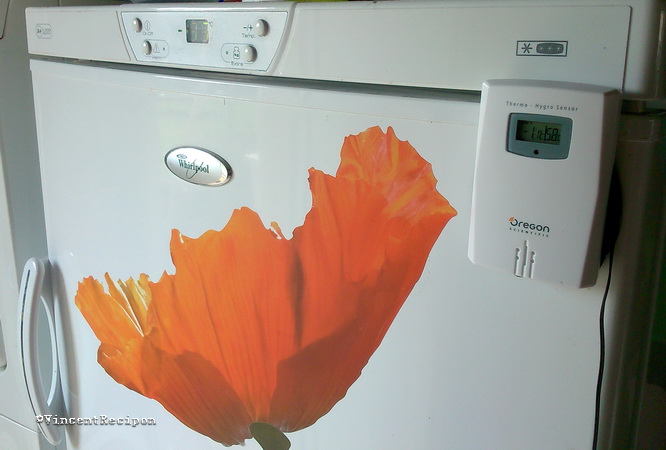


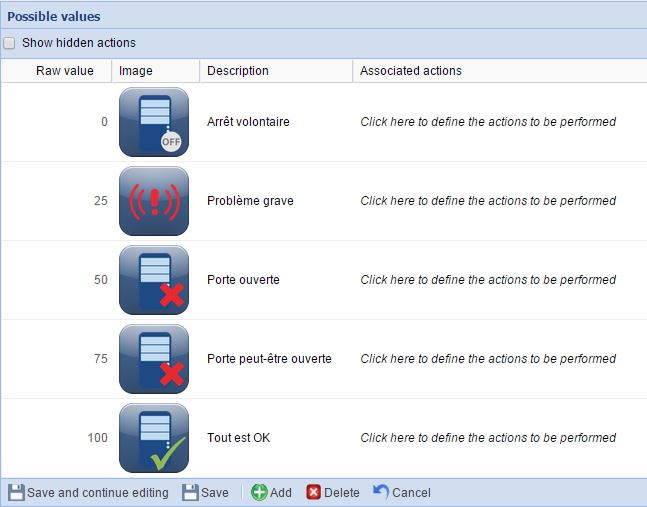





Bonjour,
Je trouve l’idée très bonne. Je pense l’adapter pour lire la température/humidité dans une cave à vin… la eedomus ne capte pas le signal de la sonde oregon.
A votre avis, que faut-il faire pour faire pareil avec le capteur d’humidité?
Merci
Le plus simple semble de déporter le petit circuit de la sonde oregon qui supporte la sonde de température et le capteur d’humidité, et de rallonger les 4 fils. Le circuit peut être mis dans une gaine thermo pour protéger les composants.
En gardant les même composants, la mesure devrait rester assez bonne. Les fils à rajouter doivent avoir une petite influence sur la mesure, mais assez faible pour quelques dizaines de centimètres de fil. Il serait mieux d’avoir des fils torsadés pour la sonde d’humidité, la mesure étant de type capacitive, le bruit généré par les ondes pourrait être récupéré par le câble et rendre instable la mesure.
Bonjour,
Pourquoi ne pas simplement mettre un détecteur d’ouverture sur la porte du congélateur ? Par exemple sur le bas de la porte pour que ce soit bien caché.
Bon OK avec la sonde on est également au courant en cas de panne de courant, mais assez tard (trop tard?) tout de même.
Oui, c’est une autre solution effectivement. Quelqu’un a t’il déjà posté quelque-chose à ce sujet ?
Meme avis que Auvray.
La sonde passe au congélateur. Testé quand.j’ai revendu mon ancien frigo/congélateur. La sonde accroché au frigo me semble pas WAF du tout… 🙂
Pourquoi se compliquer la vie ?
Depuis des mois j’ai une sonde THGR122N installée directement dans mon congélateur, lui même installé dans mon, sous-sol.
Je récupère les informations température et humidité via mon RFX433 et ma box domotique (Veralite).
J’utilise des piles on ne peut plus standard qui fonctionne parfaitement même à basse température.
Seul conseil : si vous enlevez votre sonde Oregon du congélateur, par exemple pour le décongeler, il est important de la mettre dans un autre congélateur (de frigidaire par exemple), car l’humidité créée par la remise à température ambiante et très préjudiciable à la sonde…
En dehors de ce point, aucun problème.
Bonjour,
J’ai fait le même montage avec une sonde oregon thermo simple. J’ai dû l’enlever pour l’instant.
Le fil soulève légèrement le joint de la porte et l’étanchéité n’est plus assurée. Du givre commençait à se former et le congélateur avait perdu 1 degré.
Avez-vous eu ce problème et comment l’avez-vous résolu ?
J’ai passé également le fil dans le joint. Je n’ai pas vu plus de givre qu’avant, je sens un peu plus de froid au niveau du passage de fil, mais c’est très faible. Je pense que ce qui me sauve c’est que le fil de la sonde est fin, également que le joint du congélateur est large (signe de qualité de l’appareil m’a dit un vendeur il y a 15 jours) . Pour l’instant le montage me semble suffisant.
Pour résoudre : passer au niveau du joint par un circuit imprimé souple (un flex) qui est plat et très fin , ce qu’on trouve sur certaines guirlandes lumineuses led souples.